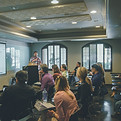
7th Grade Civics Overview
In 7th Grade Civics students will focus on the principles, functions, and organization of government; the origins of the American political system; the roles, rights, responsibilities of United States citizens; and methods of active participation in our political system. This course is also embedded with strong geographic and economic components to support civic education instruction.
Students will be able to apply knowledge of the US Constitution and demonstrate their understanding of how the American system of government functions on the local, state and national levels as well as the impact on individual citizens. Students will also be able to demonstrate their understanding that US citizens have both rights and responsibilities in order for our government to maintain order in our society.
The Learning Environment



To create and establish a cohesive, safe environment for students from all walks of life it is vital to to communicate, interact and work effectively with individuals and groups to enhance the students learning environment.
Blending Learning
Learning Connections
Student Choice Board
Impacting Learning Outcomes

1
Communication and
Empathy
Being an excellent communicator plays a dynamic role in how a classroom functions. This can range from exchanging ideas and details with students concerning expectations regarding academic performance and behavior. In addition to this, as a teacher, it is crucial to be able to connect and understand each student in their own identity. Empathy plays a crucial role when sympathizing with my students where I can put myself in their shoes, viewing their problems in their eyes. Not only does sympathy, health build, a level of trust between student and a teacher but also it helps the teacher to help the student come up with a solution.

2
Positive Motivation and
Body Language
My students at times need an extra push and motivation when completing an assignment or task. I make sure I recognize and also celebrate my students when achieving small and big time goals. One of my favorite times during the lesson is to encourage students to believe in them in themselves and try their best in the area they might find less interesting. While, motivating the student, it is essential that I have a positive body language when it comes down to non-verbal communication and help students know that I am approachable and open minded to their ideas. It is extremely important that students feel open and safe to share their ideas and contribute to the discussion. Body language is an effective tool for maintaining good interpersonal skills.

3
Humor and
Educational Fun
Humor is one of the skills that my students loved the best throughout my class. Throughout our civics course, there are many lessons that can be applied in real life. I pride myself on dramatic, teaching in basic language to close achievement gaps where students can laugh and connect with the material. While applying, how are you thinking and having fun with the material all at once.


Diversity and Inclusion
Teaching the next generation of scholars is extremely to understanding how each student is uniquely different in their own way. To properly comprehend and encourage cultural awareness, I need to understand all the different types of diversity I may experience in my classrooms including: Race, Ethnicity, Religion, Language, Socioeconomic Status, Sexual Orientation, and Gender Identity.
MULTICULTURALISM IN THE CLASSROOM
Example will encourage all students’ cultural awareness, enhancing each student’s sense of identity, and foster inclusion in the classroom community
Get to Know Your Students
Maintain Consistent Communication
Acknowledge and Respect Every Student
Practice Cultural Sensitivity
Incorporate Diversity in the Lesson Plan
Give Students Freedom and Flexibility
Students Feel More Confident and Safe
Open Communication
Students Become More Open-Minded
Students Become More Empathetic
Students Gain a Better Understanding of Lessons and People
Students Are Better Prepared for a Diverse Workplace

Mr. Lee | Classroom
Bell ringer (also called a Warm-Up): Between five and fifteen minutes to complete.
Direct Instruction: ten to fifteen minutes
Activity: This will take up most of my class time between forty and fifty minutes to complete.
Closing: The final ten minutes of class are the most important part of a ninety-minute class period.
This is the time where students should always have a structured moment at the end of the block to pause, process, and response to their Exit Ticket
